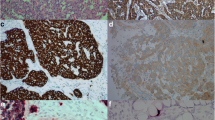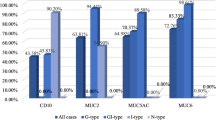Abstract
The immunohistochemical expression of caveolin-1 (cav-1) was evaluated in a series of gastric carcinomas (GC) and in the adjacent normal gastric mucosa. Cav-1 immuno-expression was found in most GC (94%) with a significantly higher amount in the Lauren intestinal type in comparison to the diffuse-type carcinomas. Interestingly, gastric intestinal metaplasia as well as the cells at the base and neck of gastric pits within all fundic mucosal fragments showed an evident cav-1 immuno-staining, suggesting a histogenetic derivation of these lesions from the trans-differentiation of chief cells or from a cryptic progenitor population at the base of fundic glands, as recently hypothesized by other authors. The absence of significant correlations between cav-1 immuno-expression and the other clinico-pathological parameters, such as the stage of disease or the patients overall survival, indicates that the role of cav-1 in GC is neither stage-specific nor related to prognosis.




Similar content being viewed by others
References
Scherer PE, Lewis RY, Volontè D et al (1997) Cell-type and tissue-specific expression of caveolin-2. Caveolins 1 and 2 co-localize and form a stable hetero-oligomeric complex in vivo. J Biol Chem 272:29337–29346
Anderson RG, Kamen BA, Tothberg KG et al (1992) Potocytosis: sequestration and transport of small molecules by caveolae. Science 255:410–411
Anderson RG (1993) Caveolae: where incoming and outcoming messengers meet. Proc Natl Acad Sci U S A 90:10909–10913
Razani B, Engelman JA, Wang XB et al (2001) Caveolin-1 null mice are viable but show evidence of hyperproliferative and vascular abnormalities. J Biol Chem 276:38121–38138
Lee H, Volonte D, Galbiati F et al (2000) Constitutive and growth factor-regulated phosphorylation of caveolin-1 occurs at the same site (Tyr-14) in vivo: identification of a c-Src/Cav-1/Grb7 signaling cassette. Mol Endocrinol 14:1750–1775
Wiechen K, Diatchenko L, Agoulnik A et al (2001) Caveolin-1 is down-regulated in human ovarian carcinoma and acts as a candidate tumor suppressor gene. Am J Pathol 159:1635–1643
Wiechen K, Sers C, Agoulnik A et al (2001) Down-regulation of caveolin1, a candidate tumor suppressor gene, in sarcomas. Am J Pathol 158:833–839
Joo HJ, Oh DK, Kim YS et al (2004) Increased expression of caveolin-1 and microvessel density correlates with metastasis and poor prognosis in clear cell renal cell carcinoma. BJU Int 93:291–296
Yang G, Timme TL, Frolov A et al (2005) Combined c-myc and caveolins-1 expression in human prostate carcinoma predicts prostate carcinoma progression. Cancer 103:1186–1194
Barresi V, Cerasoli S, Paioli G et al (2006) Caveolin-1 in meningiomas: expression and clinico-pathological correlations. Acta Neuropathol 112:617–626
Fine SW, Lisanti MP, Galbiati F et al (2001) Elevated expression of caveolin-1 in adenocarcinoma of the colon. Am J Clin Pathol 115:719–724
Kato K, Hida Y, Miyamoto M et al (2002) Overexpression of caveolin-1 in esophageal squamous cell carcinoma correlates with lymph node metastasis and pathologic stage. Cancer 94:929–933
Ando T, Ishiguro H, Kimura M et al (2007) The overexpression of caveolin-1 and caveolin-2 correlates with a poor prognosis and tumor progression in esophageal squamous cell carcinoma. Oncol Rep 18:601–609
Burgermeister E, Xing X, Röcken C et al (2007) Differential expression and function of caveolin-1 in human gastric cancer progression. Cancer Res 67:8519–8526
Fenoglio-Preiser C, Carneiro F, Correa P et al (2000) Gastric carcinoma. In: Hamilton SR, Aaltonen LA (eds) Tumours of the digestive system. IARC, Lyon, pp 39–52
Lauren T (1965) The two histologic main types of gastric carcinoma. Acta Pathol Microbiol Scand 64:34
Weir EE, Pretlow TG, Pitts A (1974) A more sensitive and specific histochemical peroxidase stain for the localization of cellular antigen by the enzyme–antibody conjugate method. J Histochem Cytochem 22:1135–1140
Barresi V, Grosso M, Barresi G (2008) Immunohistochemical evidence of caveolin-1 expression in human fetal and neonatal striated muscle and absence in the adult’s. Appl Immunohistochem Mol Morphol 16:267–273
Barresi V, Cerasoli S, Tuccari G (2008) Correlative evidence that tumor cell-derived caveolin-1 mediates angiogenesis in meningiomas. Neuropathology 28:472–478
Kato T, Miyamoto M, Kato K et al (2004) Difference of caveolin-1 expression pattern in human lung neoplastic tissue. Atypical adenomatous hyperplasia, adenocarcinomas and squamous cell carcinoma. Cancer Lett 214:121–128
Karayiannakis AJ, Syrigos KN, Chatzigianni E et al (1998) E-cadherin expression as a differentiation marker in gastric cancer. Hepatogastroenterology 45:2437–2442
Galbiati F, Volonte D, Brown AM et al (2000) Caveolin-1 expression inhibits Wnt/betacatenin/Lef-1 signaling by recruiting beta-catenin to caveolae membrane domains. J Biol Chem 275:23368–23377
Uchino S, Noguchi M, Ochiai A et al (1993) p53 mutation in gastric cancer: a genetic model for carcinogenesis is common to gastric and colorectal cancer. Int J Cancer 54:759–764
Correa P (1992) Human gastric carcinogenesis: a multistep and multifactorial process—First American Cancer Society Award Lecture on Cancer Epidemiology and Prevention. Cancer Res 52:6735–6740
Syder AJ, Guruge JL, Li Q et al (1999) Helicobacter pylori attaches to NeuAc alpha 2,3Gal beta 1,4 glycoconjugates produced in the stomach of transgenic mice lacking parietal cells. Mol Cell 3:263–274
Nozaki K, Ogawa M, Williams JA et al (2008) A molecular signature of gastric metaplasia arising in response to acute parietal cell loss. Gastroeneterology 134:511–522
Conflict of interest statement
We declare that we have no conflict of interest.
Author information
Authors and Affiliations
Corresponding author
Rights and permissions
About this article
Cite this article
Barresi, V., Giuffre’, G., Vitarelli, E. et al. Caveolin-1 immuno-expression in human gastric cancer: histopathogenetic hypotheses. Virchows Arch 453, 571–578 (2008). https://doi.org/10.1007/s00428-008-0681-y
Received:
Revised:
Accepted:
Published:
Issue Date:
DOI: https://doi.org/10.1007/s00428-008-0681-y




